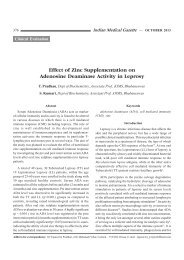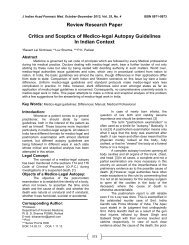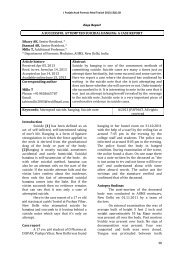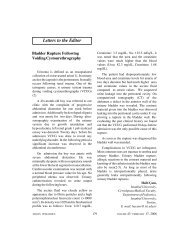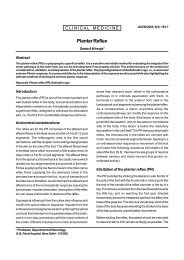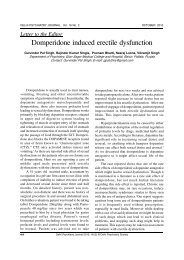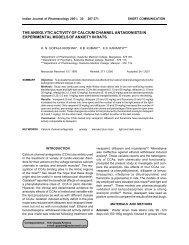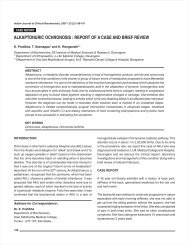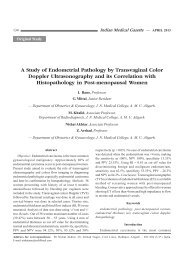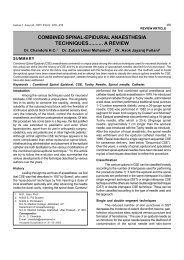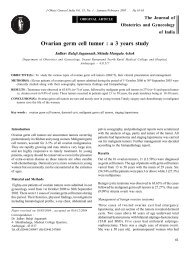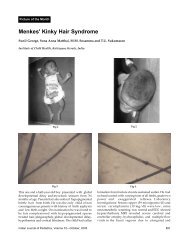Original research paper Analysis of Railway Fatalities in ... - medIND
Original research paper Analysis of Railway Fatalities in ... - medIND
Original research paper Analysis of Railway Fatalities in ... - medIND
You also want an ePaper? Increase the reach of your titles
YUMPU automatically turns print PDFs into web optimized ePapers that Google loves.
J Indian Acad Forensic Med, 32(4) ISSN 0971-0973<br />
* Ramesh NanajiWasnik<br />
<strong>Orig<strong>in</strong>al</strong> <strong>research</strong> <strong>paper</strong><br />
<strong>Analysis</strong> <strong>of</strong> <strong>Railway</strong> <strong>Fatalities</strong> <strong>in</strong> Central India<br />
Abstract<br />
A two year retrospective study <strong>of</strong> railway related fatal cases has been carried out <strong>in</strong> the Department <strong>of</strong><br />
Forensic Medic<strong>in</strong>e & Toxicology, Indira Gandhi Government Medical College, Nagpur. <strong>Railway</strong> fatality cases were<br />
stand for 5.99% (Total 173) <strong>of</strong> all autopsies (n=2888) conducted dur<strong>in</strong>g the period <strong>of</strong> January 2001 to December<br />
2002.The fatalities were predom<strong>in</strong>antly seen <strong>in</strong> the males. Male to female ratio was 8.62:1.The maximum numbers<br />
<strong>of</strong> victims were <strong>in</strong> the age group <strong>of</strong> 20-49 years (n= 120 cases, 69.34%). Majority <strong>of</strong> victims died on the spot<br />
(96.53%). Maximum number <strong>of</strong> railway fatalities were accidental (91.32 %) followed by the suicidal (8.68 %) <strong>in</strong><br />
nature, whereas none <strong>of</strong> the homicidal railway fatalities noted. Crush <strong>in</strong>juries were found mostly over lower limbs<br />
followed by the upper limb then over the face and head. Maximum victims (84.38 %) died due to hemorrhage and<br />
shock follow<strong>in</strong>g <strong>in</strong>juries to the vital organs.<br />
Key Words: Tra<strong>in</strong> Accident, <strong>Railway</strong> <strong>Fatalities</strong>, Safety, Fatal tra<strong>in</strong> Injuries, India<br />
Introduction:<br />
The <strong>in</strong>juries and deaths due to accidents are<br />
<strong>in</strong>escapable <strong>in</strong> the modern way <strong>of</strong> liv<strong>in</strong>g. The<br />
accidental deaths are mostly due to the road traffic<br />
accidents but the deaths due to railway fatalities are<br />
also not negligible, especially <strong>in</strong> the areas where<br />
railway traffic is higher. A tra<strong>in</strong> accident is def<strong>in</strong>ed as<br />
a "collision, derailment, or any other event <strong>in</strong>volv<strong>in</strong>g<br />
the operation <strong>of</strong> on-track equipments." Tra<strong>in</strong> accidents<br />
can cause devastat<strong>in</strong>g damages and personal <strong>in</strong>juries<br />
<strong>in</strong>clud<strong>in</strong>g the death <strong>of</strong> the person. Tra<strong>in</strong>s are<br />
frequently <strong>in</strong>volved <strong>in</strong> accidents that critically <strong>in</strong>jured<br />
passengers and <strong>in</strong>nocent bystanders. These accidents<br />
are <strong>in</strong>deed disastrous and catastrophic due to the speed<br />
that tra<strong>in</strong>s travel. Indeed, a tra<strong>in</strong> accident can<br />
def<strong>in</strong>itely result <strong>in</strong> loss <strong>of</strong> one‟s life or his or her<br />
property as well.<br />
Nagpur is an important city as well as an<br />
<strong>in</strong>dustrial town and the second capital <strong>of</strong> State <strong>of</strong><br />
Maharashtra. It is situated <strong>in</strong> the central part <strong>of</strong> India.<br />
As per the sensex 2001, the population <strong>of</strong> Nagpur city<br />
was 20,51,320 and that <strong>of</strong> Nagpur district was<br />
40,51,444, <strong>of</strong> which the peoples resid<strong>in</strong>g <strong>in</strong> urban<br />
area were 64.36 and <strong>in</strong> rural area were 35.64 %<br />
respectively, these areas are connected very well by<br />
the railway network. Nagpur has rapid growth <strong>in</strong><br />
educational establishments, roads, build<strong>in</strong>gs,<br />
bus<strong>in</strong>ess, energy <strong>in</strong>frastructure, <strong>in</strong>dustrialization and<br />
<strong>of</strong> course population dur<strong>in</strong>g last 25 years.<br />
Correspond<strong>in</strong>g Author:<br />
*Assistant Pr<strong>of</strong>essor<br />
Department <strong>of</strong> Forensic Medic<strong>in</strong>e<br />
Chennai Medical College & Research Centre<br />
Irungalur, Trichy-621105Tamilnadu<br />
E-mail Id: rameshwasnik@rediffmail.com<br />
311<br />
There is also <strong>in</strong>crease <strong>in</strong> the Gross National<br />
Product (GNP) and improvement <strong>in</strong> the standard <strong>of</strong><br />
liv<strong>in</strong>g.Be<strong>in</strong>g the heart <strong>of</strong> India, many national railway<br />
routes pass through the Nagpur railway station,<br />
jo<strong>in</strong><strong>in</strong>g the various states around it. Nagpur station is<br />
hav<strong>in</strong>g the heavy burden <strong>of</strong> transportation <strong>of</strong> the<br />
passengers and goods as well; therefore the<br />
<strong>in</strong>cidences <strong>of</strong> railway fatalities and mishaps are also<br />
higher at this junction. Most <strong>of</strong> the reported cases <strong>of</strong><br />
railway deaths were either directly hit by the tra<strong>in</strong> or<br />
recovered <strong>in</strong> the vic<strong>in</strong>ity <strong>of</strong> the railway tracks.<br />
Fatal railway <strong>in</strong>jury is characterized by<br />
extensive disruption <strong>of</strong> more than one body region.<br />
Hence, to properly understand the epidemiology <strong>of</strong><br />
railway deaths and the pattern <strong>of</strong> <strong>in</strong>juries produced, a<br />
retrospective analytical study has been undertaken.<br />
Material and Methods:<br />
The present retrospective study <strong>of</strong> 173 fatal<br />
cases <strong>of</strong> tra<strong>in</strong> accident has been carried out <strong>in</strong> the<br />
Department <strong>of</strong> Forensic Medic<strong>in</strong>e and Toxicology,<br />
Indira Gandhi Medical College, Nagpur for a period<br />
<strong>of</strong> two years from Jan 2001 to Dec 2002. The data<br />
was obta<strong>in</strong>ed from police <strong>paper</strong>s (Requisition and<br />
<strong>in</strong>quest Panchnama) regard<strong>in</strong>g <strong>in</strong>formation on age,<br />
sex, and supposed manner <strong>of</strong> death, pert<strong>in</strong>ent history<br />
and autopsy report.<br />
It was verified from the friends and relatives <strong>of</strong><br />
deceased. The age, sex, types <strong>of</strong> <strong>in</strong>juries, pattern and<br />
distribution <strong>of</strong> fatal <strong>in</strong>juries were noted. All the data<br />
thus collected were analyzed and f<strong>in</strong>d<strong>in</strong>gs are<br />
presented <strong>in</strong> this <strong>paper</strong>.<br />
Observation:<br />
Out <strong>of</strong> 2888 medico-legal autopsies<br />
conducted dur<strong>in</strong>g the period <strong>of</strong> two years from<br />
January 2001 to December 2002, 173 cases (5.99%)<br />
were due to tra<strong>in</strong> accidents.
J Indian Acad Forensic Med, 32(4) ISSN 0971-0973<br />
Figure1: Month Wise Distribution <strong>of</strong> <strong>Railway</strong><br />
Fatality.<br />
<strong>Fatalities</strong> by rail occur throughout the year<br />
but uniformity was not observed <strong>in</strong> the victims <strong>of</strong><br />
railway accidents. However, the fatalities were<br />
equivalently seen <strong>in</strong> all the seasons i.e. <strong>in</strong> summer<br />
season 60 cases (34.68 %), ra<strong>in</strong>y season 54 cases<br />
(31.21 %) and <strong>in</strong> w<strong>in</strong>ter season 59 cases (34.10 %).<br />
Figure 2: Age and sex wise distribution <strong>of</strong><br />
<strong>Railway</strong> fatality.<br />
The above table shows that the fatalities by<br />
the railways were predom<strong>in</strong>antly seen <strong>in</strong> the males<br />
155 cases (89.59%) as compared to females i.e. 18<br />
cases (10.40%). Male to female ratio was 8.62:1. The<br />
maximum numbers <strong>of</strong> victims were found to be <strong>in</strong> the<br />
age group <strong>of</strong> 20-49 age groups i.e. 120 cases<br />
(69.34%).<br />
Figure 3: Area- wise distributions <strong>of</strong> <strong>Railway</strong> fatality<br />
There were 122 cases (70.52%) cases from<br />
urban area while 51 cases (29.48%) cases were from<br />
rural area.<br />
312<br />
Table 1: Cases brought from<br />
Victims No. <strong>of</strong> cases %<br />
Spot 167 96.53<br />
Ward/ Casualty 6 3.46<br />
Total 173 100<br />
From the above table was clearly evident that<br />
majority <strong>of</strong> victims died on the spot 96.53% because<br />
<strong>of</strong> susta<strong>in</strong><strong>in</strong>g severe type <strong>of</strong> <strong>in</strong>juries, <strong>in</strong>sufficient<br />
ambulance services.<br />
Figure 4: Gender and manner <strong>of</strong> death <strong>in</strong> <strong>Railway</strong><br />
fatality<br />
Accidental railway fatalities were the<br />
commonest account<strong>in</strong>g to the 158 (91.32 %) cases,<br />
while the suicide seen <strong>in</strong> only 15 (8.68 %) cases<br />
whereas none <strong>of</strong> the homicidal cases were recorded.<br />
Injuries susta<strong>in</strong>ed <strong>in</strong> railway fatality shows<br />
that the crush <strong>in</strong>juries were found mostly over lower<br />
limbs (n=105), followed by the upper limb (n=102),<br />
face and head (n=72) and least <strong>in</strong> the per<strong>in</strong>eum and<br />
posterior aspect <strong>of</strong> thorax. Crush <strong>in</strong>jury to the neck <strong>in</strong><br />
the form <strong>of</strong> decapitation was observed <strong>in</strong> 27 cases.<br />
The crush separation <strong>of</strong> the trunk from the body was<br />
seen <strong>in</strong> 31 cases.<br />
Table 3: Thoracic and abdom<strong>in</strong>al organ<br />
<strong>in</strong>volvement <strong>in</strong> fatal railway accident<br />
Organ Type <strong>of</strong> <strong>in</strong>jury<br />
THORAX Contusion Crush/<br />
%<br />
Laceration<br />
Lungs 46 79 11.35<br />
Heart 7 9 88.65<br />
ABDOMEN<br />
Liver 10 71 41.75<br />
Spleen 5 49 27.83<br />
Kidney 15 44 30.41<br />
Stomach<br />
Perforation<br />
18<br />
Intest<strong>in</strong>es 37<br />
Bladder 23<br />
Crush laceration and the contusion to the<br />
lung were seen <strong>in</strong> most <strong>of</strong> the cases compare to the<br />
heart. Injury to lungs was seen <strong>in</strong> the 88.65 % cases<br />
whereas <strong>in</strong>jury to the heart accounts only <strong>in</strong> 11.35 %
J Indian Acad Forensic Med, 32(4) ISSN 0971-0973<br />
cases. Liver <strong>in</strong>jury was observed <strong>in</strong> 41.75 % followed<br />
by the kidneys (27.83 %) and the spleen (30.41 %).<br />
Table 4: Cause <strong>of</strong> death <strong>in</strong> railway fatalities<br />
Cause <strong>of</strong> Death Cases %<br />
Injuries to the Vital<br />
organs 112 64.73<br />
Head <strong>in</strong>jury 26 15.02<br />
Shock and Haemorrhage 34 19.65<br />
Septicaemia 1 0.05<br />
Total 173 100<br />
Maximum numbers <strong>of</strong> fatalities were due to<br />
<strong>in</strong>juries to vital organs i.e.112 (64.73 %). Shock and<br />
hemorrhage accounts for 34(19.65 %) alone and head<br />
<strong>in</strong>jury <strong>in</strong> 26(15.02 %) cases.<br />
Discussion:<br />
Out <strong>of</strong> 2888 medico-legal autopsies, 173<br />
cases (5.99%) were due to railway fatality. The<br />
<strong>in</strong>cidence <strong>of</strong> railway deaths is far lower <strong>in</strong> this area<br />
compare to the others [1, 2]. It was observed that the<br />
fatal tra<strong>in</strong> accidents occurred throughout the year<br />
without any uniformity and seasonal variation.<br />
<strong>Railway</strong> fatalities were 60 (34.68 %) <strong>in</strong> summer<br />
season, 54 (31.21 %) <strong>in</strong> ra<strong>in</strong>y season and <strong>in</strong> w<strong>in</strong>ter<br />
season 59 (34.10 %).<br />
<strong>Fatalities</strong> by the railway were predom<strong>in</strong>antly<br />
seen <strong>in</strong> the male <strong>in</strong> 155 cases (89.59%) as compared<br />
to female 18 cases (10.40%). Male to female ratio<br />
was 8.62:1. The male predom<strong>in</strong>ance over female was<br />
due to the fact that most <strong>of</strong> the outstation activities<br />
are usually carried out by the males. Males<br />
outnumber<strong>in</strong>g females <strong>in</strong> railway fatalities have also<br />
been observed by other. [1, 3-8] The maximum<br />
numbers <strong>of</strong> victims were found to be <strong>in</strong> the age group<br />
<strong>of</strong> 20-49 age groups i.e. 120 cases (69.34%); similar<br />
f<strong>in</strong>d<strong>in</strong>gs were observed by the others. [1, 3-5, 7-10]<br />
The passengers on the tra<strong>in</strong>, specially males <strong>of</strong> these<br />
age group takes the risk to get board<strong>in</strong>g <strong>in</strong> the<br />
runn<strong>in</strong>g tra<strong>in</strong>, hang<strong>in</strong>g on to the doors, w<strong>in</strong>dows or<br />
side bars and travell<strong>in</strong>g on the ro<strong>of</strong> gett<strong>in</strong>g <strong>in</strong>jured by<br />
low over-bridges, tunnels, also lean<strong>in</strong>g out <strong>of</strong> the<br />
w<strong>in</strong>dows <strong>of</strong> a runn<strong>in</strong>g tra<strong>in</strong> when the tra<strong>in</strong>s are<br />
overcrowded. Males are do<strong>in</strong>g most <strong>of</strong> the laborers<br />
work along the rail tracks (Gagman), try to cross the<br />
rail l<strong>in</strong>es while the tra<strong>in</strong> was nearby , takes risk to<br />
walk along the railway track, etc are the reasons to<br />
get succumb to the tra<strong>in</strong> fatalities specially by the<br />
male .<br />
There were 122 cases (70.52%) from urban<br />
areas while 51 cases (29.48%) were from rural area.<br />
<strong>Railway</strong> fatalities were predom<strong>in</strong>antly seen <strong>in</strong> the<br />
urban area as tra<strong>in</strong> transportation is the cheapest<br />
mode; urban people adopt it to make to and fro to their<br />
outstation work<strong>in</strong>g places. The factors which are<br />
responsible for higher <strong>in</strong>cidences <strong>of</strong> railway fatalities<br />
are a) <strong>in</strong> the urban area peoples resid<strong>in</strong>g <strong>in</strong> slum area<br />
usually goes nearby the railway tracks to attend their<br />
natural calls b) walks along the railway track as the<br />
short cut to reach the dest<strong>in</strong>ation early disregard<strong>in</strong>g<br />
the railway safety rules, c) encroachment <strong>of</strong> the<br />
313<br />
platforms by the people for bus<strong>in</strong>ess and other<br />
purposes. The reasons beh<strong>in</strong>d the lower <strong>in</strong>cidence <strong>of</strong><br />
railway fatalities <strong>in</strong> rural areas are that most <strong>of</strong> the<br />
villages are either far away or not connected with the<br />
railway stations and tracks. The people only<br />
occasionally avail the transport facility because <strong>in</strong><br />
such villages the major way <strong>of</strong> transport is by bullock<br />
cart or by bus etc, hence reflect<strong>in</strong>g the lower <strong>in</strong>cidence<br />
<strong>of</strong> railway fatalities <strong>in</strong> rural areas.<br />
Study clearly shows that majority <strong>of</strong> victims<br />
died on the spot because <strong>of</strong> susta<strong>in</strong><strong>in</strong>g severe type <strong>of</strong><br />
<strong>in</strong>juries, <strong>in</strong>sufficient ambulance services, which is <strong>in</strong><br />
agreement with others study. [1, 6, 8, 9, 11]<br />
Accidental railway fatality was the<br />
commonest manner than others account<strong>in</strong>g to 91.32 %<br />
cases while the suicide seen <strong>in</strong> only 8.68 % cases<br />
whereas none <strong>of</strong> the homicidal cases recorded <strong>in</strong> the<br />
railway fatalities, these are consistent with the f<strong>in</strong>d<strong>in</strong>g<br />
<strong>of</strong> various studies. [1, 2, 4, 5, 7-10] The accidental<br />
railway fatalities are due to the fall from the runn<strong>in</strong>g<br />
tra<strong>in</strong>, while board<strong>in</strong>g a runn<strong>in</strong>g tra<strong>in</strong>, while go<strong>in</strong>g<br />
hang<strong>in</strong>g on the doors etc mostly done by the males;<br />
dashed by a pass<strong>in</strong>g tra<strong>in</strong> while walk<strong>in</strong>g or cross<strong>in</strong>g<br />
along the railway tracks, shunt<strong>in</strong>g accidents, collisions<br />
or derailment etc.<br />
Injuries susta<strong>in</strong>ed by the tra<strong>in</strong> showed that<br />
crush <strong>in</strong>juries were found mostly over lower limbs<br />
followed by the upper limb, face and head, neck<br />
regions and then the thorax and abdomen. Crush<br />
<strong>in</strong>jury to the neck was observed <strong>in</strong> the 27 cases. The<br />
fractures to the lower and upper limbs with the<br />
disarticulation were the commonest one followed by<br />
head and face. The crush separation <strong>of</strong> the trunk from<br />
the body was seen <strong>in</strong> 31 cases whereas the multiple<br />
fractures to the ribs were commonly seen due to<br />
effect <strong>of</strong> shear<strong>in</strong>g and gr<strong>in</strong>d<strong>in</strong>g force from the<br />
rotat<strong>in</strong>g tra<strong>in</strong> wheels. Most <strong>of</strong> the <strong>in</strong>juries susta<strong>in</strong>ed<br />
were abrasions and contused abrasions followed by<br />
the laceration and the fracture <strong>of</strong> limbs and then the<br />
decapitation, similar f<strong>in</strong>d<strong>in</strong>gs were observed by some<br />
observant [4, 9]. The study clearly revealed that head<br />
was <strong>in</strong>jured <strong>in</strong> most <strong>of</strong> the cases followed by upper<br />
limb, neck, lower limb & trunk <strong>in</strong> descend<strong>in</strong>g order.<br />
[1, 8, 9] The other <strong>in</strong>juries were due to the primary<br />
and secondary impact. The primary impact <strong>in</strong>juries<br />
are related to the head and arms, chest, trunk as it is<br />
usually get struck from the side, which are usually<br />
multiple and extensive and the secondary <strong>in</strong>juries are<br />
due to been thrown down and run over result<strong>in</strong>g <strong>in</strong><br />
the crush<strong>in</strong>g and deep <strong>in</strong>juries. [9]<br />
Concern<strong>in</strong>g the thoraco-abdom<strong>in</strong>al organ<br />
<strong>in</strong>volvement, the crush laceration and the contusion to<br />
the lung was seen <strong>in</strong> most <strong>of</strong> the cases compared to the<br />
heart. Reason is that lung is the superficial organ than<br />
the heart and occupies maximum area <strong>of</strong> the thoracic<br />
cavity / rib cage. Most <strong>of</strong> the parts <strong>of</strong> the heart are<br />
retro-sternal therefore lungs are more vulnerable to<br />
<strong>in</strong>jury as compare to heart. The majority <strong>of</strong> serious
J Indian Acad Forensic Med, 32(4) ISSN 0971-0973<br />
<strong>in</strong>juries to the chest occurred from forced compression<br />
by the crush effect <strong>of</strong> the wheels <strong>of</strong> the tra<strong>in</strong>s.<br />
Abdom<strong>in</strong>al <strong>in</strong>juries are susta<strong>in</strong>ed follow<strong>in</strong>g the<br />
primary and secondary impact result<strong>in</strong>g <strong>in</strong> grave<br />
<strong>in</strong>juries to the abdom<strong>in</strong>al viscera.<br />
Maximum numbers <strong>of</strong> fatalities were due to<br />
<strong>in</strong>juries to vital organs 64.73 %, Shock and<br />
hemorrhage alone <strong>in</strong> 19.65 %, head <strong>in</strong>jury <strong>in</strong> 26 (15.02<br />
%) cases and <strong>in</strong> only one case septicemia was the<br />
cause <strong>of</strong> death. Maximum fatalities (84.38 %) were<br />
due to hemorrhage and shock follow<strong>in</strong>g <strong>in</strong>juries by the<br />
tra<strong>in</strong> to the different vital parts <strong>of</strong> the body and the<br />
crush amputation <strong>of</strong> the limbs, decapitation caus<strong>in</strong>g<br />
hemorrhage and shock. Similar f<strong>in</strong>d<strong>in</strong>g was observed<br />
by. [2, 4-6]<br />
Conclusion:<br />
Most <strong>of</strong> the railway fatalities were<br />
accidental <strong>in</strong> nature and <strong>in</strong> the bread earn<strong>in</strong>g age<br />
group particularly among the males. The <strong>in</strong>creas<strong>in</strong>g<br />
number <strong>of</strong> population, overcrowd<strong>in</strong>g <strong>in</strong> the tra<strong>in</strong>s,<br />
reckless and careless behaviour <strong>of</strong> the passengers,<br />
pedestrians and the tra<strong>in</strong> drivers towards safety norms<br />
are the constant causes <strong>of</strong> railway fatalities. The high<br />
levels <strong>of</strong> the railway fatalities make a strong case for<br />
the necessary accident control <strong>in</strong>terventions. Public as<br />
well as the railway authorities must take some<br />
measures to br<strong>in</strong>g down these fatalities. People must<br />
follow some easy set <strong>of</strong> laws like do not travel on<br />
footboard, do not enter or get down from runn<strong>in</strong>g<br />
tra<strong>in</strong>s, do not try to cross the level cross<strong>in</strong>g gate when<br />
it is closed, be alert and reduce your speed while<br />
approach<strong>in</strong>g railway unmanned level cross<strong>in</strong>g, never<br />
guess the speed <strong>of</strong> the tra<strong>in</strong> and adhere to the set<br />
norms <strong>of</strong> railway safety to curb this menace. The<br />
railway authority must take some steps to prevent the<br />
314<br />
accidents by acknowledg<strong>in</strong>g the safety eng<strong>in</strong>eer<strong>in</strong>g,<br />
tra<strong>in</strong><strong>in</strong>g and awareness among staff, attentive<br />
surveillance, high quality ma<strong>in</strong>tenance and strict law<br />
enforcement.<br />
References:<br />
1. Sabale PR, Mohite SC. <strong>Railway</strong> <strong>Fatalities</strong> <strong>in</strong> South West<br />
Mumbai. Medico-Legal Update - An International Journal,<br />
2010; Volume 10, Issue 1, Pr<strong>in</strong>t ISSN: 0971-720X.<br />
2. Sheikh MI, Shah JV, Patel R. Study <strong>of</strong> Deaths due to<br />
<strong>Railway</strong> Accident. Journal <strong>of</strong> Indian Academy <strong>of</strong> Forensic<br />
Medic<strong>in</strong>e, 2008; Volume 30, Issue 3, Pr<strong>in</strong>t ISSN: 0971-0973.<br />
3. Gharpure PV, Gharpure MA. The role <strong>of</strong> accidents <strong>in</strong><br />
mortality. Indian Journal <strong>of</strong> Medical Sciences, March 1959;<br />
Vol. 13, No.3: 227-231.<br />
4. Ammamullah S. <strong>Railway</strong> Death <strong>in</strong> Jammu & Kashmir.<br />
Medical News Medic<strong>in</strong>e & Law, 1983; 101-105.<br />
5. PathakA, Barai P, Mahajan AK, Rathod B, Desai KP,<br />
Basu S. Risk<strong>in</strong>g Limbs and Life – <strong>Railway</strong> fatalities <strong>in</strong><br />
Vadodara: (A Retrospective Study). Journal <strong>of</strong> Forensic<br />
Medic<strong>in</strong>e and Toxicology, 2009, Volume 26, Issue 1, Pr<strong>in</strong>t<br />
ISSN: 0971-1929.<br />
6. Bloch-Bogusławska E, Engelgardt P, Wolska E,<br />
Paradowska A. <strong>Analysis</strong> <strong>of</strong> deaths caused by rail-vehicles <strong>in</strong><br />
the materials collected by the Department <strong>of</strong> Forensic<br />
Medic<strong>in</strong>e <strong>in</strong> Bydgoszcz <strong>in</strong> the years 1992-2002.Arch Med<br />
SadowejKrym<strong>in</strong>ol, Jul-Sep 2006; 56(3): 181-186.<br />
7. Lerer LB, Matzopoulos, Richard GB. Fatal <strong>Railway</strong><br />
Injuries <strong>in</strong> Cape Town, South Africa. American Journal <strong>of</strong><br />
Forensic Medic<strong>in</strong>e & Pathology, June 1997; Volume 18,<br />
Issue 2: 144-147.<br />
8. Mohanty MK, Panigrahi MK, Mohanty S, Patnaik KK.<br />
Death due to traumatic railway <strong>in</strong>jury. Med Sci Law, 2007;<br />
47: 156-160.<br />
9. Hu YP, Cao Y, Ma KJ. <strong>Analysis</strong> <strong>of</strong> the death cases <strong>in</strong> the<br />
urban rail traffic accident <strong>in</strong> Shanghai. Fa Yi XueZaZhi, 2009<br />
Jun; 25(3): 198-199.<br />
10. Davis GG, Alexander CB, Brissie RM. A 15-Year Review<br />
<strong>of</strong> <strong>Railway</strong>-Related Deaths <strong>in</strong> Jefferson County,<br />
Alabama.American Journal <strong>of</strong> Forensic Medic<strong>in</strong>e &<br />
Pathology, December 1997; Volume 18, Issue 4: 363-368.<br />
11. Rautji R, Dogra TD. Rail traffic accidents: a retrospective<br />
study. Med Sci Law, Jan 2004; 44(1):67-70.<br />
Table 2<br />
Types <strong>of</strong> <strong>in</strong>juries <strong>in</strong> tra<strong>in</strong> victims<br />
Anatomical Site Abrasion Contused Lacerated Contusion #/Crush/<br />
abrasion Wound<br />
amputation/decapitation<br />
Head &face 4 35 85 10 72<br />
Neck 2 4 6 3 27<br />
Thorax anterior 2 36 9 6 40<br />
Thorax posterior 3 13 4 3 17<br />
Abdomen anterior 4 16 3 6 31<br />
Abdomen posterior 6 11 9 1 22<br />
Upper limb 12 37 21 4 102<br />
Lower limb 16 37 39 3 105<br />
Per<strong>in</strong>eum region 8 1 5 0 17



